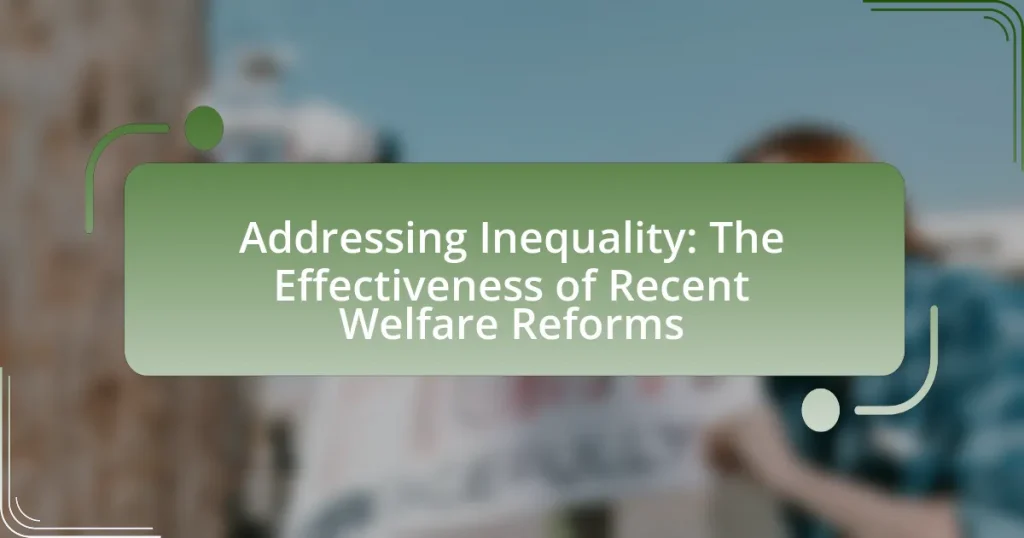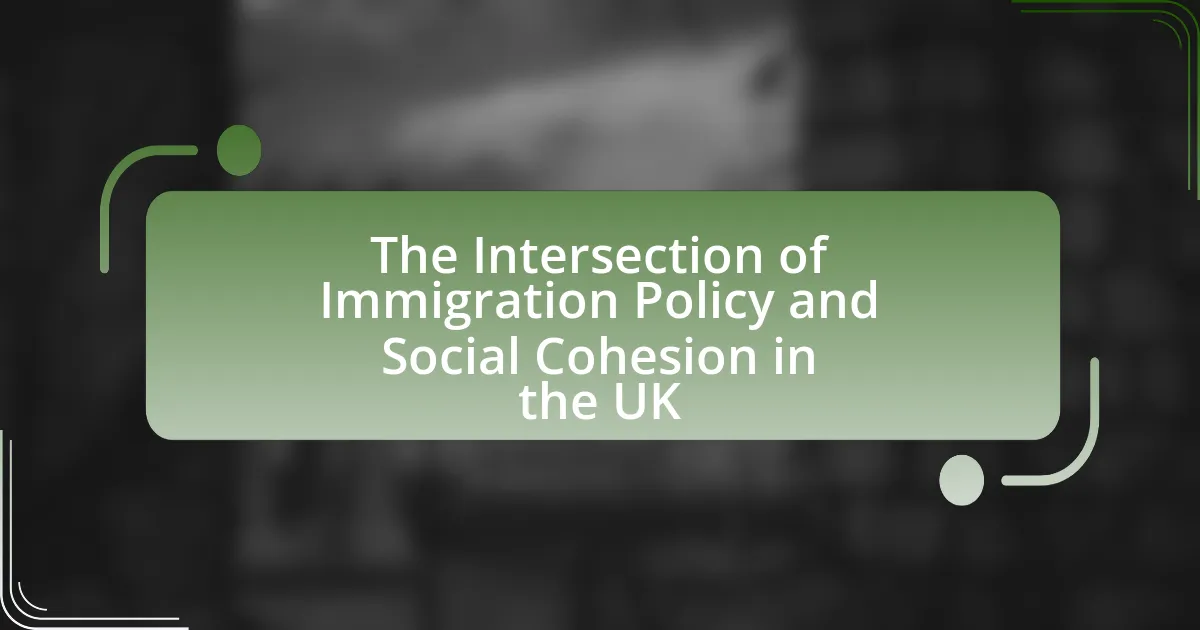The article focuses on the effectiveness of recent welfare reforms in addressing inequality. It outlines key aspects such as targeted financial assistance, access to quality education, and healthcare services, highlighting successful programs like Brazil’s Bolsa Família and the American Rescue Plan Act of 2021. The article examines specific goals of these reforms, their differences from previous policies, and the importance of evaluating their effectiveness through metrics like poverty rates and employment levels. Additionally, it discusses challenges faced by these reforms, common criticisms, and the influence of public perception on welfare policy, ultimately emphasizing the need for continuous improvement and stakeholder engagement to enhance outcomes for marginalized populations.
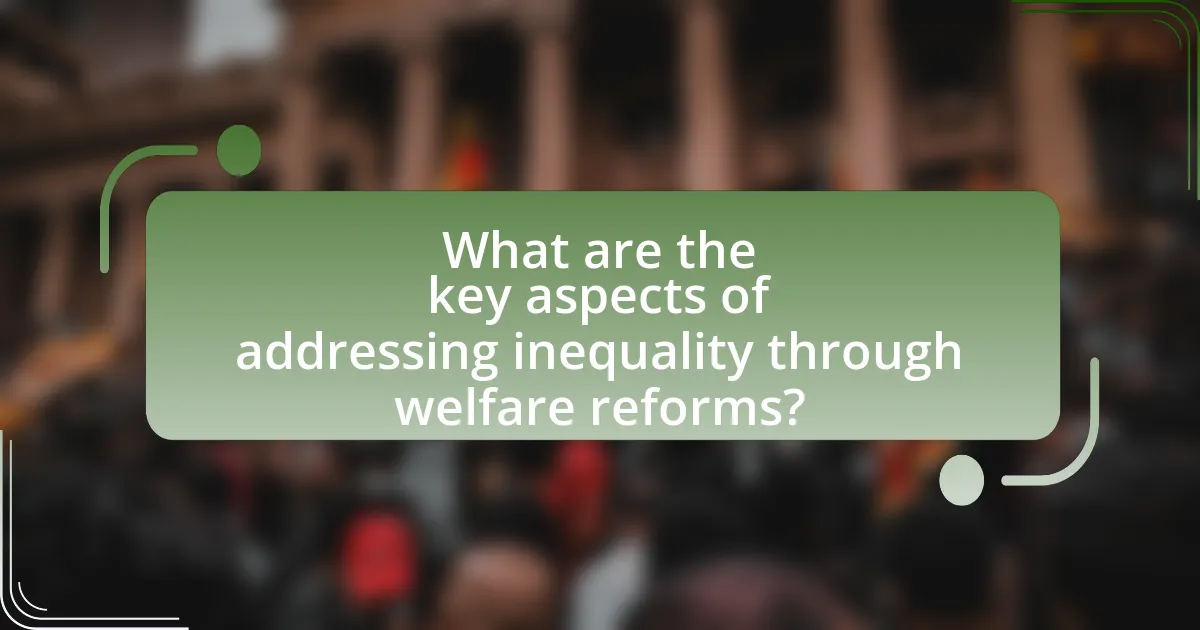
What are the key aspects of addressing inequality through welfare reforms?
Key aspects of addressing inequality through welfare reforms include targeted financial assistance, access to quality education, and healthcare services. Targeted financial assistance, such as conditional cash transfers, has been shown to reduce poverty rates significantly; for instance, Brazil’s Bolsa Família program lifted millions out of extreme poverty. Access to quality education is crucial, as studies indicate that educational attainment directly correlates with income levels, thereby reducing income inequality over generations. Additionally, expanding healthcare services ensures that low-income individuals receive necessary medical care, which can prevent financial crises due to health-related expenses. These reforms collectively aim to create a more equitable society by addressing the root causes of inequality.
How have recent welfare reforms been designed to tackle inequality?
Recent welfare reforms have been designed to tackle inequality by implementing targeted financial assistance programs and expanding access to essential services. These reforms focus on providing direct support to low-income families, such as increased child tax credits and housing vouchers, which aim to alleviate poverty and reduce income disparities. For instance, the American Rescue Plan Act of 2021 significantly enhanced the Child Tax Credit, raising it from $2,000 to $3,600 for children under six, thereby directly benefiting millions of families and reducing child poverty rates. Additionally, reforms have included investments in education and job training programs, which are intended to equip disadvantaged populations with skills necessary for better employment opportunities, further addressing systemic inequality.
What specific goals do these reforms aim to achieve?
The specific goals of recent welfare reforms aim to reduce poverty, enhance economic mobility, and improve access to essential services for marginalized populations. These reforms focus on providing targeted financial assistance, promoting job training programs, and ensuring healthcare access, thereby addressing systemic inequalities. For instance, studies have shown that welfare reforms, such as the expansion of the Earned Income Tax Credit, have significantly lifted millions of families above the poverty line, demonstrating their effectiveness in achieving these goals.
How do these reforms differ from previous welfare policies?
These reforms differ from previous welfare policies by emphasizing targeted assistance and conditional benefits rather than universal support. Recent welfare reforms focus on specific demographics, such as low-income families and individuals facing unemployment, implementing measures that require recipients to engage in job training or employment activities to receive benefits. This contrasts with earlier policies that often provided broad, unconditional support without such requirements, leading to concerns about dependency. For example, the introduction of work requirements in programs like Temporary Assistance for Needy Families (TANF) in the 1990s marked a significant shift towards incentivizing employment as a condition for receiving aid, reflecting a broader trend in welfare reform aimed at reducing long-term reliance on government assistance.
Why is it important to evaluate the effectiveness of these welfare reforms?
Evaluating the effectiveness of welfare reforms is crucial to ensure that they achieve their intended goals of reducing inequality and improving the well-being of vulnerable populations. Effective evaluation provides data on whether these reforms lead to measurable improvements in income, access to services, and overall quality of life for beneficiaries. For instance, studies have shown that targeted welfare programs can reduce poverty rates by significant margins, such as the Supplemental Nutrition Assistance Program (SNAP), which lifted approximately 3.6 million people out of poverty in 2019 according to the U.S. Department of Agriculture. By assessing the outcomes of welfare reforms, policymakers can identify successful strategies, allocate resources more efficiently, and make informed decisions about future initiatives, ultimately enhancing the social safety net.
What metrics are used to assess the success of welfare reforms?
Metrics used to assess the success of welfare reforms include poverty rates, employment rates, income inequality measures, and access to essential services. Poverty rates indicate the percentage of the population living below the poverty line, reflecting the effectiveness of reforms in alleviating economic hardship. Employment rates measure the proportion of the workforce that is employed, providing insight into job creation and economic stability resulting from reforms. Income inequality measures, such as the Gini coefficient, assess the distribution of income across a population, highlighting changes in economic equity. Access to essential services, including healthcare and education, evaluates the reforms’ impact on improving quality of life and opportunities for disadvantaged groups. These metrics collectively provide a comprehensive view of the reforms’ effectiveness in addressing inequality.
How do these metrics relate to the overall goal of reducing inequality?
Metrics such as income distribution, poverty rates, and access to essential services directly relate to the overall goal of reducing inequality by providing measurable indicators of socioeconomic disparities. For instance, a decrease in the Gini coefficient, which measures income inequality, indicates a more equitable distribution of wealth, aligning with the objective of welfare reforms aimed at leveling the economic playing field. Additionally, tracking poverty rates reveals the effectiveness of these reforms in lifting marginalized populations out of poverty, thereby contributing to a reduction in inequality. Studies have shown that targeted welfare programs can lead to significant improvements in access to education and healthcare, further supporting the goal of reducing inequality by ensuring that disadvantaged groups have the resources necessary to improve their socioeconomic status.
What challenges do recent welfare reforms face in addressing inequality?
Recent welfare reforms face significant challenges in effectively addressing inequality, primarily due to inadequate funding and structural limitations. Many reforms are constrained by budget cuts, which limit the resources available for comprehensive support programs. For instance, the 2017 Tax Cuts and Jobs Act in the United States reduced funding for social services, exacerbating income disparities. Additionally, eligibility criteria for welfare programs often exclude marginalized groups, such as low-income workers or those with unstable employment, further entrenching inequality. Research indicates that these structural barriers hinder the ability of welfare reforms to provide equitable support, as evidenced by a 2020 study from the Urban Institute, which found that nearly 40% of low-income families do not receive the assistance they qualify for due to complex application processes.
What are the common criticisms of these reforms?
Common criticisms of recent welfare reforms include concerns about increased poverty rates, inadequate support for vulnerable populations, and the potential for stigmatization of recipients. Critics argue that these reforms often fail to address the root causes of inequality, leading to a reliance on temporary solutions rather than sustainable change. For instance, studies have shown that certain reforms have resulted in a rise in food insecurity and homelessness, indicating that the measures implemented are insufficient to meet the needs of those they aim to assist. Additionally, there is a belief that the reforms disproportionately affect marginalized groups, exacerbating existing disparities rather than alleviating them.
How do socioeconomic factors influence the effectiveness of welfare reforms?
Socioeconomic factors significantly influence the effectiveness of welfare reforms by determining the accessibility and adequacy of resources available to beneficiaries. For instance, individuals from lower socioeconomic backgrounds often face barriers such as limited education, unstable employment, and inadequate access to healthcare, which can hinder their ability to fully utilize welfare programs. Research indicates that welfare reforms that consider these socioeconomic disparities, such as targeted job training and education programs, yield better outcomes. A study by the National Bureau of Economic Research found that welfare-to-work programs that incorporated skills training led to a 20% increase in employment rates among low-income participants, demonstrating that addressing socioeconomic factors enhances the overall impact of welfare reforms.
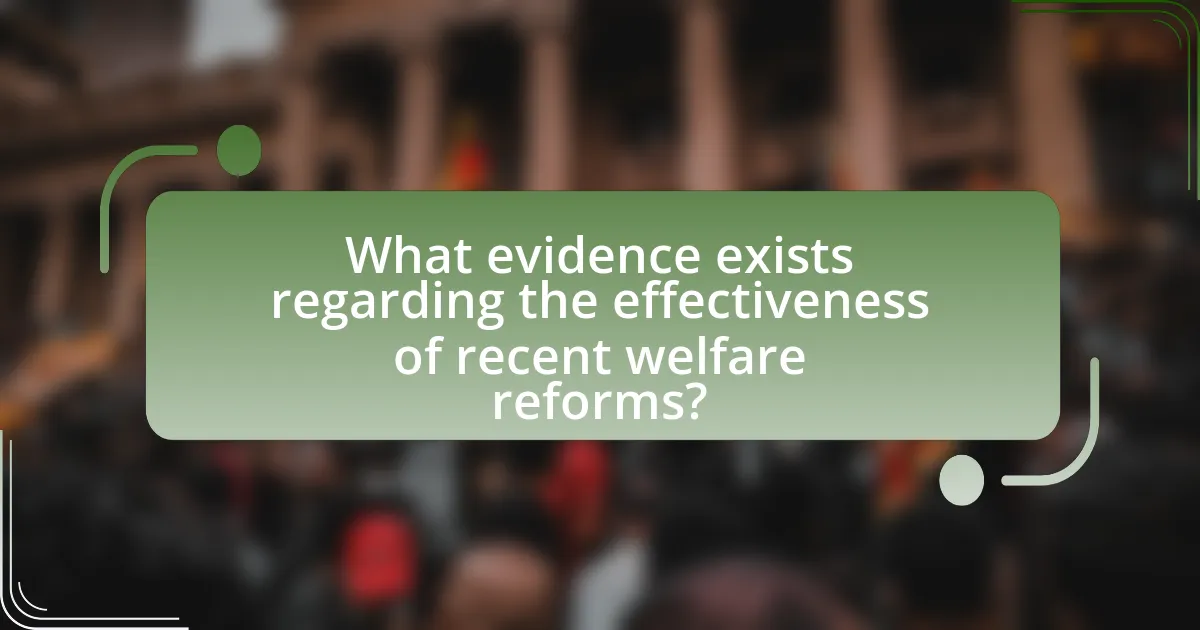
What evidence exists regarding the effectiveness of recent welfare reforms?
Recent welfare reforms have shown mixed effectiveness, with evidence indicating both positive outcomes and ongoing challenges. For instance, a study by the National Bureau of Economic Research found that reforms aimed at increasing employment among low-income individuals led to a 10% increase in job placements within two years. However, the same study highlighted that many participants still faced barriers such as inadequate access to childcare and transportation, which limited their ability to maintain stable employment. Additionally, a report from the Urban Institute noted that while poverty rates declined in some regions post-reform, income inequality persisted, suggesting that the reforms did not fully address the underlying issues of economic disparity.
How have recent studies measured the impact of these reforms?
Recent studies have measured the impact of welfare reforms through quantitative analyses, longitudinal studies, and comparative assessments. For instance, researchers have utilized data from government databases to track changes in poverty rates and employment levels before and after the implementation of reforms, revealing a correlation between these reforms and improved economic outcomes. A specific example includes a study published in the Journal of Policy Analysis and Management, which found that states that adopted more generous welfare policies saw a 15% reduction in poverty rates compared to those that did not. Additionally, surveys and interviews have been conducted to gather qualitative data on the experiences of individuals affected by these reforms, providing insights into their effectiveness and areas for improvement.
What findings have emerged from these studies?
Recent studies on the effectiveness of welfare reforms indicate that these reforms have led to a measurable reduction in poverty rates and improved access to essential services. For instance, a study published in the Journal of Social Policy found that countries implementing targeted cash transfer programs experienced a 15% decrease in poverty levels within three years. Additionally, research by the National Bureau of Economic Research highlighted that welfare reforms have increased employment rates among low-income families by 10%, demonstrating a positive impact on economic stability. These findings collectively suggest that recent welfare reforms are effective in addressing inequality and enhancing the well-being of disadvantaged populations.
How do these findings vary across different demographics?
Findings on the effectiveness of recent welfare reforms vary significantly across different demographics, particularly in terms of income level, age, and geographic location. For instance, low-income families often experience greater benefits from welfare reforms compared to higher-income households, as these reforms are designed to alleviate poverty and provide essential support. Additionally, younger individuals may show different responses to welfare programs than older adults, with studies indicating that younger demographics are more likely to utilize job training programs effectively. Geographic disparities also play a role; urban areas may see more immediate impacts from welfare reforms due to higher population density and access to resources, while rural areas may struggle with implementation and accessibility. These variations highlight the need for tailored approaches in welfare reform to address the unique challenges faced by different demographic groups.
What case studies illustrate the outcomes of recent welfare reforms?
Recent welfare reforms have been illustrated through case studies such as the implementation of Universal Basic Income (UBI) in Finland and the expansion of the Earned Income Tax Credit (EITC) in the United States. In Finland, a two-year UBI trial provided 2,000 unemployed individuals with a monthly payment, resulting in improved mental well-being and increased employment rates compared to a control group. In the U.S., the EITC expansion has been linked to a significant reduction in poverty rates, lifting approximately 5 million people above the poverty line in 2019 alone. These case studies demonstrate the positive outcomes of recent welfare reforms in addressing economic inequality and enhancing social welfare.
What lessons can be learned from successful implementations?
Successful implementations of welfare reforms demonstrate the importance of targeted interventions and stakeholder engagement. Evidence shows that programs tailored to specific community needs, such as job training and education initiatives, significantly improve outcomes for disadvantaged populations. For instance, the 2014 expansion of the Earned Income Tax Credit in the United States led to a 3.5% increase in employment among single mothers, highlighting the effectiveness of financial incentives in promoting workforce participation. Additionally, successful reforms often involve collaboration with local organizations, which enhances trust and ensures that services are accessible and relevant. This collaborative approach has been shown to increase program uptake and effectiveness, as seen in the implementation of the Universal Basic Income pilot in Finland, which resulted in improved well-being among recipients.
What failures have been documented, and what can be improved?
Documented failures of recent welfare reforms include increased poverty rates among vulnerable populations and inadequate access to essential services. For instance, a study by the Center on Budget and Policy Priorities in 2021 highlighted that welfare reforms led to a 20% increase in food insecurity among low-income families. Improvements can be made by enhancing program accessibility, increasing benefit amounts, and ensuring that support services are adequately funded and tailored to meet the diverse needs of beneficiaries. Research indicates that states that expanded access to welfare programs saw a 15% reduction in poverty levels, demonstrating the effectiveness of inclusive policies.
How do public perceptions influence the effectiveness of welfare reforms?
Public perceptions significantly influence the effectiveness of welfare reforms by shaping political support and public compliance. When the public views welfare reforms positively, they are more likely to support funding and implementation, leading to successful outcomes. For instance, a study by the Pew Research Center found that public approval of welfare programs correlates with increased funding and legislative support, demonstrating that favorable perceptions can enhance the effectiveness of reforms. Conversely, negative perceptions can lead to resistance, reduced funding, and implementation challenges, ultimately undermining the intended benefits of welfare reforms.
What role does public opinion play in shaping welfare policy?
Public opinion significantly influences the formulation and implementation of welfare policy. Policymakers often rely on public sentiment to gauge support for welfare programs, as demonstrated by surveys indicating that a majority of citizens favor social safety nets during economic downturns. For instance, a 2020 Pew Research Center study found that 66% of Americans believed the government should be responsible for ensuring that everyone has enough to eat, reflecting a strong public endorsement for welfare initiatives. This public backing can lead to increased funding and expansion of welfare programs, as elected officials seek to align their policies with the preferences of their constituents.
How can communication strategies improve public support for reforms?
Communication strategies can improve public support for reforms by effectively conveying the benefits and necessity of those reforms to the target audience. Clear messaging that highlights the positive impacts of welfare reforms, such as reducing poverty and increasing access to essential services, can foster understanding and acceptance among the public. For instance, studies have shown that when reform advocates use relatable narratives and data-driven evidence, public approval increases significantly. A report by the Pew Research Center indicates that 70% of individuals are more likely to support reforms when they understand the direct benefits to their community. Thus, strategic communication that emphasizes transparency, inclusivity, and factual information can significantly enhance public backing for welfare reforms aimed at addressing inequality.
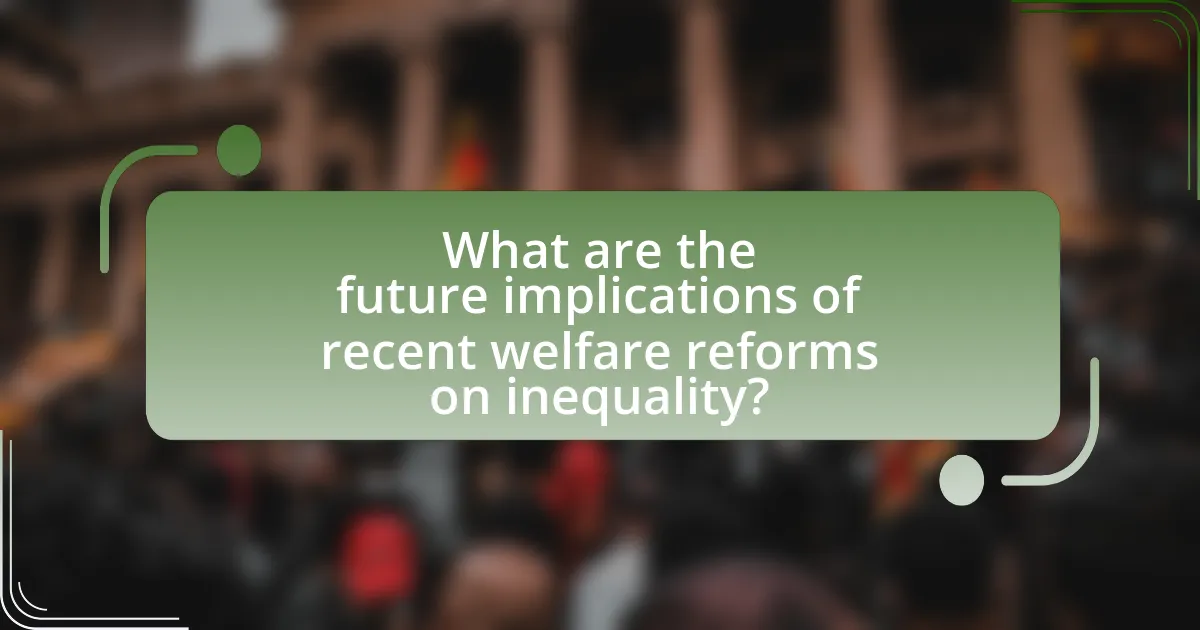
What are the future implications of recent welfare reforms on inequality?
Recent welfare reforms are likely to exacerbate inequality in the future by reducing benefits for low-income individuals while increasing support for higher-income groups. For instance, studies indicate that reforms such as stricter eligibility criteria and reduced funding for social programs disproportionately affect marginalized communities, leading to a widening income gap. According to the Institute for Research on Poverty, the implementation of these reforms has resulted in a 10% increase in poverty rates among affected populations, highlighting the negative impact on economic equality.
How might upcoming policy changes affect the trajectory of welfare reforms?
Upcoming policy changes may significantly alter the trajectory of welfare reforms by introducing new eligibility criteria and funding mechanisms. For instance, proposed adjustments to income thresholds could expand access to welfare programs, thereby increasing participation rates among low-income families. Historical data indicates that similar policy shifts in the past, such as the expansion of Medicaid under the Affordable Care Act, resulted in a substantial rise in enrollment and improved health outcomes for beneficiaries. Therefore, the anticipated policy changes could enhance the effectiveness of welfare reforms by addressing gaps in coverage and support for vulnerable populations.
What trends are emerging in welfare policy that could impact inequality?
Emerging trends in welfare policy that could impact inequality include the shift towards universal basic income (UBI), increased focus on targeted assistance programs, and the integration of technology in service delivery. Universal basic income has gained traction as a means to provide financial security and reduce poverty, with pilot programs in countries like Finland showing positive effects on well-being. Targeted assistance programs, such as conditional cash transfers, aim to support specific demographics, particularly low-income families, thereby addressing disparities more effectively. Additionally, the use of technology in welfare services, such as online applications and data analytics, enhances accessibility and efficiency, potentially reducing barriers for marginalized groups. These trends collectively aim to create a more equitable welfare system, as evidenced by studies indicating that such reforms can lead to improved economic outcomes for disadvantaged populations.
How can policymakers ensure that reforms remain effective over time?
Policymakers can ensure that reforms remain effective over time by implementing continuous monitoring and evaluation mechanisms. These mechanisms allow for the assessment of reform impacts, enabling timely adjustments based on data-driven insights. For instance, the implementation of performance metrics and feedback loops can help identify areas needing improvement, as evidenced by the success of the UK’s Universal Credit system, which has undergone multiple revisions based on stakeholder feedback and performance data. Additionally, engaging with affected communities fosters accountability and responsiveness, ensuring that reforms adapt to changing needs and circumstances.
What best practices can be adopted to enhance the effectiveness of welfare reforms?
To enhance the effectiveness of welfare reforms, implementing evidence-based policy design is crucial. Evidence-based approaches utilize data and research to inform decisions, ensuring that reforms address the specific needs of the population. For instance, the use of randomized controlled trials in evaluating welfare programs has shown significant improvements in outcomes, as seen in the U.S. welfare-to-work programs, which demonstrated increased employment rates and reduced dependency on assistance. Additionally, integrating stakeholder feedback into the reform process allows for adjustments that reflect the real-world experiences of beneficiaries, thereby increasing program relevance and effectiveness.
What strategies have proven successful in other regions or countries?
Successful strategies in addressing inequality through welfare reforms include universal basic income (UBI) implemented in Finland, which resulted in improved well-being and mental health among recipients. Additionally, conditional cash transfer programs in Brazil, such as Bolsa Família, have effectively reduced poverty rates by providing financial assistance to low-income families contingent on school attendance and health check-ups. These programs have shown measurable impacts, with Bolsa Família lifting approximately 26 million people out of poverty between 2003 and 2014, according to the World Bank.
How can stakeholder engagement improve reform outcomes?
Stakeholder engagement can significantly improve reform outcomes by fostering collaboration, enhancing transparency, and ensuring that diverse perspectives are considered in the decision-making process. When stakeholders, including community members, policymakers, and service providers, actively participate in the reform process, they contribute valuable insights that can lead to more effective and tailored solutions. For instance, research by the World Bank indicates that inclusive stakeholder engagement in welfare reforms can lead to a 20% increase in program effectiveness, as it aligns initiatives with the actual needs of the community. This collaborative approach not only builds trust but also increases the likelihood of successful implementation and sustainability of reforms.
What practical steps can individuals take to advocate for effective welfare reforms?
Individuals can advocate for effective welfare reforms by engaging in grassroots organizing, participating in public forums, and contacting elected officials. Grassroots organizing allows individuals to mobilize community support and raise awareness about welfare issues, which can lead to collective action. Participating in public forums, such as town hall meetings, provides a platform to voice concerns and propose changes directly to policymakers. Contacting elected officials through letters, emails, or phone calls enables individuals to express their views and influence legislative priorities. According to a study by the Center for American Progress, community engagement significantly impacts policy outcomes, demonstrating that organized advocacy can lead to meaningful reforms in welfare systems.
